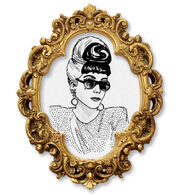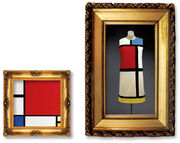V71: The Asian Issue (Summer 2011)[]
Lady Gaga covered the 'Asia' edition. 10% of the proceeds will go towards the Japan relief efforts.
Gaga's first column (Memorandum), in which she shares her thoughts on fashion and gives an exclusive look into her world, will appear in the new issue. The piece will be accompanied by illustrations made by Gaga’s fans.
- Interview by Elton John, photoshoot by Inez and Vinoodh
- Promotional images
Born Again[]
The most outrageous and talked-about performer of today is also turning out to be the smartest and most unflinchingly honest. Lady Gaga’s new album proves that being number one doesn’t mean your dance music can’t be deeply and stirringly personal. If anything, that’s all it needs to be
Photography Inez van Lamsweerde & Vinoodh Matadin Styling by Nicola Formichetti Interview by Elton John
With her new album, Lady Gaga is getting personal. Not that the superstar musician hasn’t already laid her soul bare countless times in songs, performances, and even on the runway at the Mugler show in Paris this past March. It’s just that on Born This Way she’s unquestionably singing from the heart—about social injustice, self-acceptance, forgoing Hollywood, and the recent passing of her grandfather, among other tough topics. As Gaga grows up—she celebrated her 25th birthday two days after this cover shoot—songs about late nights and hard partying are naturally transitioning into those about identity, vulnerability, and, ultimately, pure joy. That’s what’s different about the Gaga of 2011—she has undoubtedly found herself. Here, Elton John asks his dear friend (and the godmother of his new baby boy) exactly how she got there.
ELTON JOHN Growing up, who were your musical heroes?
LADY GAGA I grew up listening to my father’s vinyl collection. You, Bruce Springsteen, Billy Joel, Michael Jackson, Pink Floyd, Led Zeppelin, Mick Jagger, Neil Young, Bob Dylan, James Taylor, Carole King, Whitney Houston, Duran Duran. I had an affinity for rock and roll and dance music at a young age, especially for artists who wrote and played themselves. I started playing piano when I was 4, so the idea of creating something on my own that could someday live next to Dark Side of the Moon—that became an ultimate driving force in my childhood.
EJ At what point in your life has music had its greatest influence?
LG I remember listening to Carole King’s Tapestry album in my parents’ basement at two in the morning, singing and screaming at the top of my lungs, then finishing up papers and harnessing as much bravery as possible to be confident in a very socially challenging school environment. This is just one of many moments. But this was around the time that I began to write really great songs. I was 16.
EJ Were you encouraged to perform as a child?
LG There was no stopping me. I was always in a moment of performance and creativity. My parents encouraged me in that they never tried to change me. But in a way, my home has always been the stage. I was the girl whose phone was ringing off the hook because I was late to meet everyone at the party, I was too busy finishing a chord progression or lyric, dreaming of getting my boots dirty and becoming a superstar.
EJ Does your family support your current lifestyle and commitments?
LG Wholeheartedly, except they’re afraid I work too hard. My dad’s a whiskey mouth like me, though, so we don’t argue much about my recreational life: booze and recording.
EJ You have been on the road with your Monster’s Ball tour since late 2009 and have performed over 180 shows with still more to go. How does touring affect you physically and emotionally?
LG At a certain point exhaustion becomes a state of being, and mentally I have to be strong and overcome it. It’s like a cloud, a fog really, that hovers over me. But in a way I will never escape it, because in truth when I do have time to rest I end up writing a song, or editing a film, or creating a new project for the fans to be involved in. Art is my whole life. The monsters are my medicine. They heal me, physically and emotionally, every night at the show.
EJ What’s the most spectacular thing you have ever seen when looking into an audience?
LG Myself. It’s like a magnificent disco ball, with twenty thousand tiny mirrors reflecting back at me. It requires me to be honest. I see myself in my fans. I feel God through their love. I worship little monsters. They’re my religion. Without them, I don’t exist.
EJ Do you feel your life and your act have become inextricably intertwined?
LG Yes. Where I begin and where the stage ends has no linear quality. It’s centrifugal.
EJ When do you feel the most free?
LG Onstage, especially at the piano. However the most defining moments of liberation always occur when I am performing a new song for the first time. I have never before felt the energy and freedom that I do now singing “Born This Way” at the end of the show. It was the finale I had yet to write. It was the end of the unfinished, and never finished, story of the Monster’s Ball. I spoke of freedom and identity every night for three years. But artistically, not until now have I put my money where my mouth is. The celebration is so intense with the fans. It’s unlike any feeling I’ve ever had before.
EJ We share a flamboyant taste in fashion. Who or what inspires you?
LG I’m mostly inspired by shapes, and using the body to create iconography. Leather culture and high-street punk fashion. I would say perfecto jackets occupy most of my fashion thoughts. We were laughing on the set of the “Judas” video—we had fifty racks of couture, and I wore leather, Motorhead panties made of a vintage T-shirt, custom from young designers who are my friends, my own creations, and archive Christian Lacroix from a museum. There are no rules.
EJ What music are you listening to at the moment?
LG Gregorian chanting. Édith Piaf, I’ve been obsessed with her throughout the making of Born This Way. And metal.
EJ What can people expect on Born This Way? Will it be hard-core or reflective or both?
LG The album is a meditation with my psychology. It begins with “Marry the Night,” a song about refusing Hollywood and moving back to New York, and it takes you, through the rest of the songs, to what is a paradoxical condition for me as a musician: I must be wholly superstar and wholly human to be a great artist. The album reckons with being private in public and liberating myself, and hopefully others, from their insecurities. In “Hair” I talk about discovering my identity in high school, and in “Americano” I tackle the social injustices that my generation faces now. Now that I have the courage of my fans, and the potential for revolution, I feel obligated to address what I see in their eyes every night, something I wasn’t ready to do on my first two albums. Sonically it’s an exploration in pop, dance, metal, techno, and rock, and fuses these genres with a variety of textures and colors; it’s a very painterly approach to music. It is quite aggressive and intense, like me, but the melodies are sweeping and beautiful. The album finishes with “The Edge of Glory,” a song about death. After losing my grandfather this year, I realized that the ultimate glorious moment when you are passing is when you realize that you won at life. So, yes, it’s quite hard-core in that it’s the hard-hitting work I’ve done, but [the album has] softer moments of vulnerability where I am quite joyful, and girlish, and enjoying being 25.
EJ Which track on the new album is the most personal?
LG They are all personal, I wrote and co-produced every song. But “Marry the Night” is the deepest look into my heart and mind as a woman of New York.
EJ What is the future of Lady Gaga?
LG I don’t know. I’m still trying to figure out what I’m going to wear later.

Illustration by Charles McNeill, the winner of the Drawn This Way contest.
V MAGAZINE MEMORANDUM No. 1[]
Date: MAY 2011
Re: PIET MONDRIAN & LIBRARY CARDS
From: M†SS.GAGA
To: STEPHEN GAN
Copy to: HAUS OF GAGA
LADY STARLIGHT
NICOLA FORMICHETTI
FREDERIC ASPIRAS
V COLLECTIVE
LITTLE MONSTERS
THE WORLD
FASHION-SEXUALS
ANDY WARHOL
NEW YORK PUBLIC LIBRARY
BULLIES
Glam culture is ultimately rooted in obsession, and those of us who are truly devoted and loyal to the lifestyle of glamour are masters of its history. Or, to put it more elegantly, we are librarians. I myself can look at almost any hemline, silhouette, beadwork, or heel architecture and tell you very precisely who designed it first, what French painter they stole it from, how many designers reinvented it after them, and what cultural and musical movement parented the birth, death, and resurrection of that particular trend. So dear critics and bullies: get your library cards out, because I’m about to do a reading.
An expertise in the vocabulary of fashion, art, and pop culture requires a tremendous amount of studying. My studio apartment on the LES, quite similar to many of my hotel suites now (knock on wood), was covered in inspiration. Everything from vintage books and magazines I found at the Strand on 12th Street to my dad’s old Bowie posters to metal records from my best friend Lady Starlight to Aunt Merle’s hand-me-down emerald-green designer pumps were sprawled all over the floor about two feet from my bathroom and four inches from my George Foreman Grill. (Starlight was always jealous that mine had a bun warmer and hers didn’t.) And in my downtime, which meant whenever I wasn’t waitressing, go-go dancing, or making mixtapes for a music publishing company in Times Square, I was analyzing and studying my library. I would dream of being a rock star who dressed like Marc Bolan, walked like Jerry Hall, and had the panache of Ginger from Casino and the mystery of Isabella Blow.1 See footnote.

Composition with Red, Blue and Yello, 1930. Artwork Piet Mondrian (Left), Yves Saint Laurent, Fall/Winter 1965/66 (Right)
Any writer, or anyone for that matter, who doesn’t understand the last two sentences of this column should NEVER be writing about or critiquing fashion or artists in publication. As someone who references and annotates her work vigilantly, I am putting all of you on notice. I’ve done my homework, have you? Where are your library cards? Did they expire? When Yves Saint Laurent designed the “Mondrian” day dress for fashion week Fall/Winter 1965, did he plagiarize or revolutionize? Some people would say he was unoriginal, that he traced an iconic contemporary artwork by Piet Mondrian, and stole it for his own merits. Others may argue that by referencing something so “before its time,” he influenced an entire generation in fashion that transformed the female body with a more linear sensibility, graphics, and painterly shape. We now call it “mod.” Picass said, “Good artists copy; great artists steal.” Maybe he only said that because he and Matisse were in a bitchy queen fight for two decades (some called it a boxing match, I call it a conversation in art). But maybe it’s just that the resolution is: art gives birth to new art. There is no chicken or egg. It’s molecular. Cells give birth to cells. To put it more bluntly, the Hussein Chalayan vessel I wore at the Grammys wasn’t inspired by a chicken. It was stolen from an egg. But the transformation, the context, and the approach taken to reinterpret the meaning of birth and rebirth in terms of fame on a fucking red carpet — this is what creates the modernity of the statement. The past undergoes mitosis, becoming the originality of the future.
The Haus of Gaga, my (our) own pop-cultural family and living Warholian factory, talked endlessly about the initial vision for “Born This Way.” On the set of the video, it was almost terrifyingly important to me that I tribute Rico (the Zombie Boy’s) tattoos, creating a visual metaphor where tattoos, along with the body modification I had been exploring, became a subcultural symbol for rebirth. Rico in this case was my Mondrian. After I put the makeup on, I found myself dancing and flailing at 9 a.m., after twenty-four hours of no sleep on set. Feeling young and free, it occurred that the makeup allowed me to erase the public’s perception of my beauty, and define it for myself. I asked Rico, “Why did you tattoo yourself this way?” (Something I imagine he’s asked quite frequently.) He said very genuinely, with no hesitation, “Bazooka gum.”2 See footnote. And just like that, as many of the creations in my brain take form, I realized, and so did the Haus, that not only did I need to reunite with my youth, i.e. “Bazooka gum,” but that my fans needed to see me in that juvenile way in order to understand the intention behind why I wrote “Born This Way.” Accompanied with a side ponytail, it took me back to moments when I was just a little baby monster. When my mother would perch a pony high on my hair and we would dance so hard to the tape deck that the perfectly perched pony she fashioned would fall to the side. I had to take an uncomfortable journey back into high school, where my youth represented tears. Wishing I had a mask. Hoping that I could artistically hide the wounds buried deep from years of being bullied. I have since reckoned with this psychology in my performance art. But this time, the revelation was clear: I still want to wear the mask, but now I wear it proud, and with the same effervescence and innocence I had when I was 6, dancing with my mom.
After I performed “Born This Way” at the Grammys, it seemed as though the piece was interpreted as an engagement for battle. And the whole performance was a battle cry in essence — for freedom against forces of inequality and prejudice. But as quickly as the song catapulted to number one, a more subtle controversy exploded. “Born This Way” was a triumph as a pop song and a social statement, but it ultimately revealed another division: the reality that the young generations’ challenges with equality and social justice are just as prevalent now as they were twenty-five years ago. And while “Born This Way” was written for every walk of life, I began to feel my youngest fans were longing to be nurtured, while others felt they already had been. Perhaps in this way the song was not for everyone, although the intention was such. And perhaps I was naïve to hope everyone would unfold the true meaning of my performance piece the way I unfolded YSL’s “Mondrian” dress. Instead, I am caught between two forces: one holding onto a ponytail, and another screaming “I don’t want to be angry, I want to be free.”
“I DON’T WANT TO BE A DRAG, I JUST WANT TO BE A QUEEN.”
I have a passionate understanding of the history of many of the references that not only I have reinspired, but have been reinterpreted over centuries of fashion: where they came from, what they meant, and specifically how they became modern again. I have concurrently shown that I could “read you” in this subject, but I would rather reckon with the fact that many are clinging tightly to cultural divisiveness and leaving home without library cards.
Just like sometimes Picasso was Matisse’s Mondrian, and vice versa. Bowie is often my Mondrian, as are Michael Jackson, Prince, Lita Ford, and Madonna. Mugler is my silhouette’s Mondrian, Cindy Crawford is my sexuality’s, Kermit is my whimsy’s, and, in my “Born This Way” video, two of my Mondrians were Francis Bacon and Salvador Dalí. In a lot of ways the “idea” of being obsessed with art is my Mondrian. Just like Campbell’s Tomato Soup was Warhol’s Mondrian, and Marilyn Monroe and Maripol were Madonna’s. I am obsessed with all the authors in the library of pop culture.
I do not define, however, my artistry or historical relevance with one particular fashion or musical statement. And I don’t believe any of the artists I mentioned do either. Rather, I find freedom in my ability to transform and liberate myself (and others) with art and style — because those are the things that freed me from my sadness, from the social scars. Furthermore, I am in no way encouraging anyone to emulate my fashion sense, but rather setting a, hopefully, liberating example for anyone to look inside and know they can become any image or projection imaginable. I am an obsessed pop cultural expert. And, perhaps, between my music, performance art, and this column, I will be remembered as such. After weeks of writing this article I asked out loud, “What do you think YSL would think of my metaphor about his collection?” My darling hair designer Frederic replied, “You could ask Nan Kempner, but she’s dead.” Now that’s a queen who never left home without her library card.
1. Mirrored bikini inspired by Bolan Scuba Suit, Mugler runway model walk, a past romance with drugs and costume jewelry à la Scorsese. Lobster Philip Treacy hat.
2. For those of you who’ve never had it, it’s a retro chewing gum that comes with whimsical stick-on temporary tattoos.


















